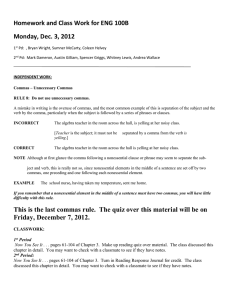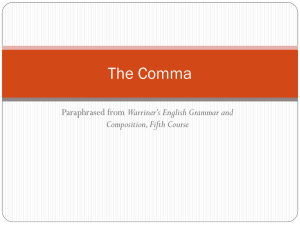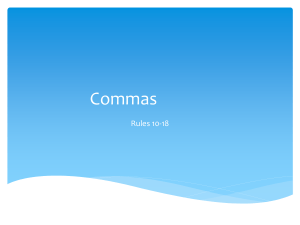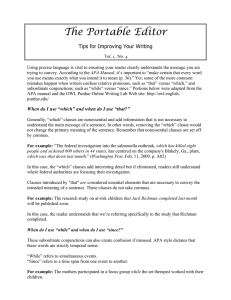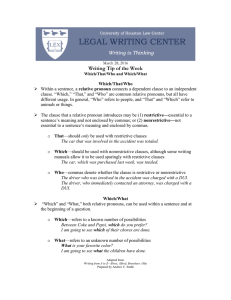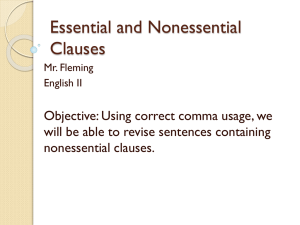Homework and Class Work for ENG 100B Tuesday, Nov. 13, 2012
advertisement
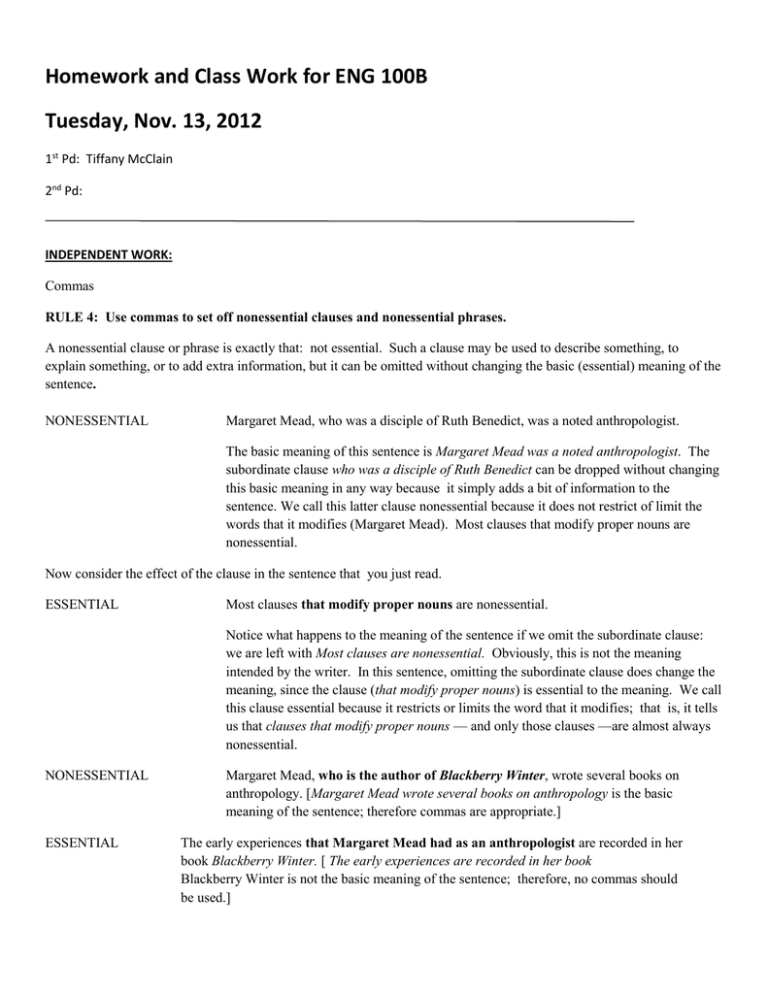
Homework and Class Work for ENG 100B Tuesday, Nov. 13, 2012 1st Pd: Tiffany McClain 2nd Pd: INDEPENDENT WORK: Commas RULE 4: Use commas to set off nonessential clauses and nonessential phrases. A nonessential clause or phrase is exactly that: not essential. Such a clause may be used to describe something, to explain something, or to add extra information, but it can be omitted without changing the basic (essential) meaning of the sentence. NONESSENTIAL Margaret Mead, who was a disciple of Ruth Benedict, was a noted anthropologist. The basic meaning of this sentence is Margaret Mead was a noted anthropologist. The subordinate clause who was a disciple of Ruth Benedict can be dropped without changing this basic meaning in any way because it simply adds a bit of information to the sentence. We call this latter clause nonessential because it does not restrict of limit the words that it modifies (Margaret Mead). Most clauses that modify proper nouns are nonessential. Now consider the effect of the clause in the sentence that you just read. ESSENTIAL Most clauses that modify proper nouns are nonessential. Notice what happens to the meaning of the sentence if we omit the subordinate clause: we are left with Most clauses are nonessential. Obviously, this is not the meaning intended by the writer. In this sentence, omitting the subordinate clause does change the meaning, since the clause (that modify proper nouns) is essential to the meaning. We call this clause essential because it restricts or limits the word that it modifies; that is, it tells us that clauses that modify proper nouns — and only those clauses —are almost always nonessential. NONESSENTIAL ESSENTIAL Margaret Mead, who is the author of Blackberry Winter, wrote several books on anthropology. [Margaret Mead wrote several books on anthropology is the basic meaning of the sentence; therefore commas are appropriate.] The early experiences that Margaret Mead had as an anthropologist are recorded in her book Blackberry Winter. [ The early experiences are recorded in her book Blackberry Winter is not the basic meaning of the sentence; therefore, no commas should be used.] NONESSENTIAL twenty- The Homecoming Parade, which is sponsored by the student council, will feature three floats this year. ESSENTIAL Anyone who appreciates the color and movement will enjoy seeing Alexander Calder’s mobiles. Understanding the difference between essential and nonessential clauses can be a valuable help in expressing the exact meaning that you have in mind. If commas were never used, some clauses could often be interpreted as either essential or nonessential. EXAMPLE Science fiction writers (,) who are concerned about machines dominating people (,) frequently write about computer-controlled societies. EXAMPLE Science fiction writers (,) who are concerned about machines dominating people (,) frequently write about computer-controlled societies. Notice the commas in parentheses. If these commas are included in the sentence, we have one meaning; if they are omitted, we have another, and very different, meaning. When commas are used, the writer is saying that science fiction writers write about computer-controlled societies; the information in the subordinate clause merely explains why they do so. Without the commas, however, the subordinate clause is essential, and the meaning of the sentence is that only writers who are concerned about machines dominating people would write about computer-controlled societies.CLASSWORK: CLASSWORK: 1. Read Now You See It . . . Read Chapter 8 and Complete Reading Response Journal.
